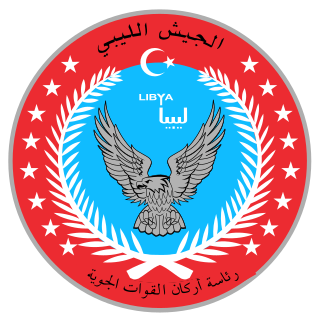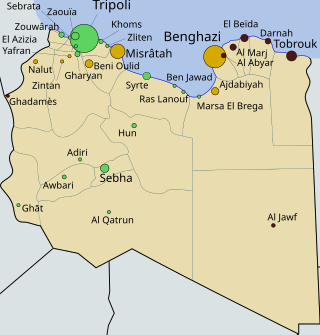
The Libyan Air Force is the branch of the Libyan Armed Forces responsible for aerial warfare. In 2010, before the Libyan Civil War, the Libyan Air Force personnel strength was estimated at 18,000, with an inventory of 374 combat-capable aircraft operating from 13 military airbases in Libya. Since the 2011 civil war and the ongoing conflict, multiple factions fighting in Libya have been in possession of military aircraft. As of 2019, the Libyan Air Force is nominally under the control of the internationally recognised Government of National Accord in Tripoli, though the rival Libyan National Army of Marshal Khalifa Haftar also has a significant air force. In 2021, the air force was under command of the new President of Libya, Mohamed al-Menfi that replaced Fayez al-Sarraj.

Abdul Ati al-Obeidi was a Libyan politician and diplomat. He held various top posts in Libya under Muammar Gaddafi; he was Prime Minister from 1977 to 1979 and General Secretary of General People's Congress from 1979 to 1981. He was one of three main negotiators in Libya's decision to denounce and drop their nuclear weapons program.

The Libyan civil war, also known as the First Libyan Civil War, was an armed conflict in 2011 in the North African country of Libya that was fought between forces loyal to Colonel Muammar Gaddafi and rebel groups that were seeking to oust his government. The war was preceded by protests in Zawiya on 8 August 2009 and finally ignited by protests in Benghazi beginning on Tuesday 15 February 2011, which led to clashes with security forces who fired on the crowd. The protests escalated into a rebellion that spread across the country, with the forces opposing Gaddafi establishing an interim governing body, the National Transitional Council.

Abu-Bakr Yunis Jabr was a Libyan military officer and politician was the Libyan Secretary of the Libyan General Committee for Defence during the rule of Muammar Gaddafi. His official position was Secretary of the Libyan General Interim Committee for Defence.

Abdul Fatah Younis Al-Obeidi was a senior Libyan military officer. He held the rank of major general and the post of minister of interior, but resigned on 22 February 2011 and defected to the rebel side in the First Libyan Civil War. He was considered a key supporter of Muammar Gaddafi or even No. 2 in the Libyan government.

The battle of Misrata, also known as the siege of Misrata, was a battle of the 2011 Libyan Civil War for the control of Misrata. It was fought between troops loyal to the government of Muammar Gaddafi, and anti-Gaddafi rebels who held Misrata, the third largest city in Libya. Following the initial stages of the uprising, the Libyan government retook most towns in the west of the country, leaving Misrata the only major city under rebel control in Tripolitania. The city soon became the site of one of the war's major battles and the suffering of its citizens gained worldwide attention.
Khamis Gaddafi was the seventh and youngest son of former Libyan leader Muammar Gaddafi, and the military commander in charge of the Khamis Brigade of the Libyan Army. He was part of his father's inner circle. During the Libyan Civil War in 2011, he was a major target for opposition forces trying to overthrow his father.
Estimates of deaths in the 2011 Libyan vary with figures from 15,000 to 30,000 given between March 2 and October 2, 2011. An exact figure is hard to ascertain, partly due to a media clamp-down by the Libyan government. Some conservative estimates have been released. Some of the killing "may amount to crimes against humanity" according to the United Nations Security Council and as of March 2011, is under investigation by the International Criminal Court.
The Free Libyan Air Force was the air force of the National Transitional Council during the First Libyan Civil War. It was established by and was a collection of Libyan Air Force defectors with captured aircraft that aligned themselves with the anti-Gaddafi forces in the civil war.
Iman al-Obeidi is a former Libyan postgraduate law student who received worldwide media attention during the Libyan Civil War. This was because she burst into the restaurant of the Rixos Hotel in Tripoli and told the international press corps there that Libyan troops had beaten and gang-raped her. Her public statement challenged both the Gaddafi government and the taboo against discussing sex crimes in Libya.

Moussa Ibrahim Gaddafi is a Libyan political figure who rose to international attention in 2011 as Muammar Gaddafi's Information Minister and official spokesman, serving in this role until the government was toppled the same year in the Libyan Civil War. Ibrahim held frequent press conferences in the course of the war, denouncing rebel forces and the NATO-led military intervention, often in defiant and impassioned tones. His status and whereabouts remained unknown following the Battle of Tripoli in which the Gaddafi government was overthrown, although there were several claims and subsequent refutations of his capture. Eventually, in late 2014, it was discovered he was in Egypt before he was deported and fled to Serbia. On 12 January 2015 Moussa Ibrahim spoke publicly by video link at a political event hosted at the Committee Rooms Houses of Parliament, Westminster, London from an undisclosed location, also the Director of Private Security Company.
The outbreak of the Libyan Civil War was followed by accusations of human rights violations by rebel forces opposed to Muammar Gaddafi, Gaddafi's armed forces, and NATO. The alleged violations include rape, extrajudicial killings, ethnic cleansing, misconduct and bombings of civilians.
The Battle of the Misrata frontline was a battle during the Libyan Civil War between pro-Gaddafi loyalists and anti-Gaddafi forces on the western and southwestern outskirts of Misrata, the third largest city in Libya. It ended when anti-Gaddafi soldiers secured Zliten to the west and Tawergha to the south, establishing a significant buffer zone around the city.
The Battle of Zliten followed an unsuccessful uprising in Zliten, Libya, during the Libyan Civil War. It began on 21 July 2011 when elements of the National Liberation Army, part of the anti-Gaddafi forces seeking to overthrow the government of Muammar Gaddafi, moved into the city of Zliten after struggling over the course of the past several months to extend the frontline westward from Misrata, the second-largest city in rebel hands.

The Libyan Civil War began on 15 February 2011 as a chain of civil protests and later evolved into a widespread uprising against the regime of Muammar Gaddafi. On 25 February, most of eastern Libya was reported to be under the control of protesters and rebel forces. Gaddafi remained in control of the cities of Tripoli, Sirte and Sabha. By 15 March, however, Gaddafi's forces had retaken more than half a dozen lost cities. Except for most of Cyrenaica and a few Tripolitania cities the majority of cities had returned to Gaddafi government control.

The timeline of the Libyan civil war begins on 15 February 2011 and ends on 20 October 2011. The conflict began with a series of peaceful protests, similar to others of the Arab Spring, later becoming a full-scale civil war between the forces loyal to Muammar Gaddafi's government and the anti-Gaddafi forces. The conflict can roughly be divided into two periods before and after external military intervention authorized by United Nations Security Council Resolution 1973.
The Battle of Tawergha was a military engagement of the Libyan Civil War that began on 11 August 2011 when anti-Gaddafi forces based in Misrata advanced southeast along the road to Sirte in the early morning and attacked Libyan Army positions in the town of Tawergha. It ended on 13 August when rebel troops, after capturing the town, cleared it of snipers and artillery positions threatening Misrata.

The Libyan Civil War began on 15 February 2011 as a civil protest and later evolved into a widespread uprising. However, by 19 March, Libyan forces under Colonel Muammar Gaddafi were on the brink of a decisive victory over rebels in Libya's east. That day, leading NATO members acted on United Nations Security Council Resolution 1973 which authorized member states "to take all necessary measures... to protect civilians and civilian populated areas under threat of attack in the Libyan Arab Jamahiriya, including Benghazi, while excluding an occupation force".

The 2011 Libyan Civil War began on 17 February 2011 as a civil protest and later evolved into a widespread uprising. After a military intervention led by France, the United Kingdom, and the United States on 19 March turned the tide of the conflict at the Second Battle of Benghazi, anti-Gaddafi forces regrouped and established control over Misrata and most of the Nafusa Mountains in Tripolitania and much of the eastern region of Cyrenaica. In mid-May, they finally broke an extended siege of Misrata.

The killing of Muammar Gaddafi took place on 20 October 2011 after the Battle of Sirte. Muammar Gaddafi, the deposed leader of Libya, was captured by NTC forces and executed shortly afterwards.









